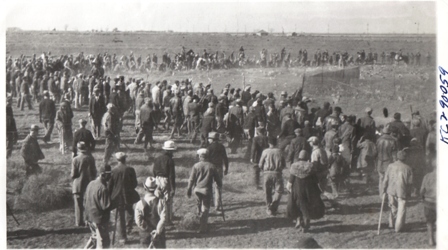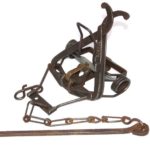Description
So, you think you catch a lot of Rabbits ?
One of our Australian customers once told me a story about the ‘rabbit drives’ which he remembered taking place when he was a boy. The problems caused by rabbits in Australia are well known and a textbook example of what can happen when a non-native species is released and thrives in its new habitat. Even so the events he described sounded just a little too farfetched and it wasn’t until recently that I found out he wasn’t exaggerating at all!
The first rabbits were introduced into the Australian continent in 1788 by ‘First Fleet’ and kept in cages and specially built walled enclosures as warrens. They thrived, particularly in Tasmania, and on that isolated island there were soon thousands estimated to be living wild on some estates. With no opportunity to spread to the mainland this didn’t really present too much of an issue. However it was on Christmas Day 1859 that the real problems began. Thomas Austin released just twenty-four European rabbits, along with 5 hares and 72 partridges, all of which he had imported to improve the sporting game on his estate of Barwon Park near Geelong in the colony of Victoria. The story goes that Thomas’s nephew, who had been charged with supplying the rabbits from England, had been unable to obtain enough wild rabbits before the ship was due to sail. So instead he bought a few of a domestic breed to make up the numbers. These two strains cross bred once released in Australia and some people say that this new hybrid strain was what made the Australian rabbit so devastating. Whether that’s true or not, what is certain is that these rabbits found the Australian habitat suited them and spread like a bushfire.
Those 24 rabbits did incredibly well. Just a few years after introducing them, Thomas Austin reported that during the two-year period 1865- 1866 he and his guests had killed at least 34,000 rabbits in sport. By 1872 rabbits were in plague proportions in the eastern states and eating out pasture, so landowners petitioned the government to make destruction of rabbits compulsory. In New South Wales it is estimated that 10 million rabbits were killed between January to August 1887.
In 1901 the rabbit proof fence project was started but was largely ineffective and by the late 1930s the rabbits had reached crisis point. It took until the 1950s for any real progress was made with the release of the myxomatosis virus and the follow up ‘rabbit calicivirus disease’ in 1996.
It’s hard to imagine what it must have been like for people on the land during those difficult years if the early 1900s. News and social archives reveal the incredible scale of the infestation and the impact it had on peoples everyday lives. For anyone interested in what the realities were like, there’s a wealth of true life recollections in the book Great Australian Rabbit Stories by Jenny Quealy*.
In a desperate attempt to control the rabbits, farmers and landowners used every and any method that they could. Traditional trapping using the standard 3 inch gin traps was a successful and popular method, but some traps were a bit more innovative and on a whole larger scale. In the Australian bush water is often in short supply during the summer months and famers built huge water tanks or dams to store rain water. Rabbits trying to survive in this parched landscape could smell the water and were drawn to the dams in huge numbers. Sometimes, when water levels were low, the rabbits trying to reach the water simply toppled over the edge and drowned. Other more enterprising farmers encircled their dams with mesh fences, equipped with narrowing mesh funnels to allow the rabbits in but confuse them when they tried to escape. An early job every morning would be to collect and dispatch those rabbits caught during the night. One report quotes the record for a single night’s catch by this method at 1500 rabbits but another tells of a trap built round a dam at Thackaringa in far west New South Wales which caught 20,000 rabbits over three night period.
Poisoning was another popular method and cost effective way to kill rabbits in large numbers. Strychnine and later a specially developed poison ‘1080’ were administered by cutting thistle root into chunks about an inch long and soaking them in the poison. Sugar and sometimes vanilla were often mixed in as added attractants to make the bait just that little more interesting. These bait pieces were then ‘sown’ in a long line either straight onto the ground or into a shallow furrow. This method worked extremely well with examples of 500 to 600 rabbits being poisoned in one night on just 1500 acres.
An alternative would be to use poisoned wheat, boiled up with enough arsenic to ‘cover a five-cent piece’. One account describes how the treated wheat was put into a container and taken out on horseback. The farmer would drag a sturdy pole behind him and the horse to make a shallow groove into which he would throw handfuls of the poisoned bait.
Dogs were also regularly used to control rabbits, but not quite in the way that we would recognise in the UK – no dark nights on the lamp or dogs slipped for a challenging 1 on 1 course. Dogs were used in large packs, an irregular mix of breeds accepting any dog that was a proven ‘good rabbiter’. These packs would be taken miles around a farm by a rabbit catcher on horseback or even a bicycle and would kill every rabbit that they could. One story tells of Ernie Kilmartin who ran a pack of sixty to seventy dogs on a 5500 acre farm surrounded by a stone wall. His pack included fox terriers, spaniels, greyhounds and staghounds and would go out every day, with the dogs frequently catching up to 200 rabbits day after day.
Most spectacular of all though were the rabbit drives and the story my Australian customer described seems to have been a common occurrence in 1930s Australia. These events were not just to keep the rabbits in check but the sales of the rabbits were important fund raisers for football clubs, and even hospitals. These were community events involving everyone in the area and as many friends as they could muster. People from all parts of the community would all gather together at an appointed place and time – men, women and children. They’d then form a huge circle, or arc sometimes being taken out in cars and trucks to be dropped off at regular intervals. At the agreed signal everyone would begin to all steadily walk in together, making as much noise as they could. Sometimes shaking tins of stones, banging metal trays, waving sticks or using whatever they had brought with them. The rabbits would be driven forward in front of them towards huge wire mesh pens. These would be shaped like a giant funnel, narrowing down to pinch point with a large holding area behind. Here the rabbits would be killed, paunched and paired together before being loaded for transport to the buyers.
Apart from simply controlling a serious pest, caught rabbits did have some financial worth. The main value was in their fur, which was used to make the famous Acubra hats and poison left the coats undamaged. It took between eight to thirteen rabbits to make an Akubra hat and during the 1920s and 1930s they were standard equipment for every Australian man. In 1938 and 1939 the quantity of rabbit skins exported from Australia was 4,433,000 pounds weight at a value of £429,000. In the five years ending 1947/1948 exports averaged 12,650,000 pounds weight, representing £5 million in value.
The rabbits were of course used for their meat but there were so many caught that a whole industry grew up to collect, chill and transport them. This included the eventual freezing and export of rabbits back to Europe. One eyewitness account describes how they saw 130 crates leave town in one morning, each crate containing twenty-two pairs of rabbits. That’s over 5000 rabbits! Which during the winter period and represented two days’ catch. In 1949, McCraith, another exporter, shipped 205,000 crates, or 6 million rabbits, to England. Jack McCraith ceased operations that same year but over the preceding thirty year period exported 130 million rabbits to England.
Incredible though the rabbit drives might sound, I was surprised to discover that they were not limited to just Australia. At the same time in the American states of Kansas, Nebraska and California, rabbit drives were a regular control method for the American Jack Rabbit – a native of the USA but none the less a major pest. A member of the hare family rather than a true rabbit, it was even more suitable for above ground methods of control. There are five species of jackrabbits, all found in central and western North America. They are speedy animals capable of reaching 40 miles an hour and their zig-zag running pattern, combined with leaps of up to 10 feet make them very difficult for predators to catch. Black-tailed jackrabbits are common in American deserts, scrublands, and other open spaces and will eat very large quantities of grasses and plants. The white-tailed jackrabbit is the other common species and prefers North America’s plains and farmlands, though they will also inhabit woodland. They will each eat half a kilogramme of grasses, shrubs, or bark each day. Females can give birth to several litters a year, each with one to six young which become quickly independent
In the dustbowl of the 1930s and in the midst of a depression, the Jack Rabbit became the focus of large scale public action. It is reported that in October 1934 Cheyenne County paid out a bounty on 11,000 pair of ears. A little later in December 1934 Kimball County paid bounty on 100,000 pair of ears, after a large hunt consisting of 800 men in a drive over nine sections.
So next time you have a day rabbiting and don’t grumble too much when it comes to cleaning your kill – just imagine getting the short straw after a rabbit drive !
Further sources of information
Australia
*Great Australian Rabbit Stories by Jenny Quealy. Published by HarperCollins and available on Kindle.
USA
The Kansas Historical Society ‘kansapedia’
http://www.kshs.org/portal_kansapedia
Kansas Memory
www.kansasmemory.org
Contains original film footage of rabbit drives: Kansas Emergency Relief Committee accomplishments movie – segment 8 the Drought of 1934



Reviews
There are no reviews yet.